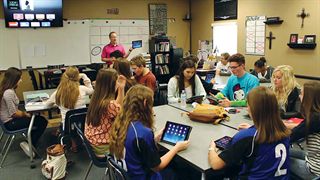
This year, students at Valley Christian High School in Chandler, Arizona, are considering not only the possibilities of technology but the importance of leaving an ethical digital footprint. In an age when what was said or done can go viral within minutes, these students are considering the ramifications of instant communication and the ways their faith can and should influence their internet behavior.
“Our required year-long computer literacy class includes about a half of a semester focused on digital citizenship: teaching ethics for a moral compass to everything we do online,” first-year faculty member and computer teacher Tom Croke said. “We live in an age where we all have digital footprints; digital citizenship is understanding what footprints we leave and how they impact us.”
The course was piloted by the Bible Department last year to prepare juniors to use iPads in the classroom, but it soon became clear that all students could benefit from the course, and this year the school expanded it to all computer literacy classes as a core objective.
The school is working with Common Sense Media to create the curriculum, which looks at examples from the real world and considers what a Christian response would be in those circumstances. “We are able to integrate scripture and discuss where we get our moral compass,” Croke said. “For example, when talking about cyberbullying, I asked students what Scripture says about treating others and how this applies. We can discuss values and the root of our moral compass. Essentially, I take Common Sense’s provided resources and make them distinctly Christian.
“In addition to including Christian worldview, we are constantly updating the materials to keep up with the times,” said Croke. “When it was originally created, Facebook was the primary social media medium for students. However, as I found out from students, Facebook is ‘for old people’ and Twitter is old, too. Students are primarily using Instagram, so next year’s material will be changed to reflect this new medium.”
“I work to update the material to stay current with the issues,” said Croke. “When discussing copyright issues, Twitter users were being sued by the NFL for posting GIFs of plays. This fit into the debate of fair use versus copyright. When Black Lives Matter protests sprung up around the country, we were in the hate speech material, so it fit as a natural tie-in to ongoing news.”
While cyberbullying and copyright issues are discussed, the class also identifies positive digital footprints; for example, a student-athlete who was discovered, recruited, and offered an athletic scholarship for college because of a positive social media footprint.
“At first students were apprehensive and felt it was too common sense,” said Croke. “And sometimes it is; however, it does allow us to talk about topics with technology that are often not addressed such as hate speech, sexting, and copyright issues. Because we live in a digital age, these are all pressing issues that need to be addressed.”